2012 Hyundai Sonata service
[x] Cancel search: servicePage 317 of 363
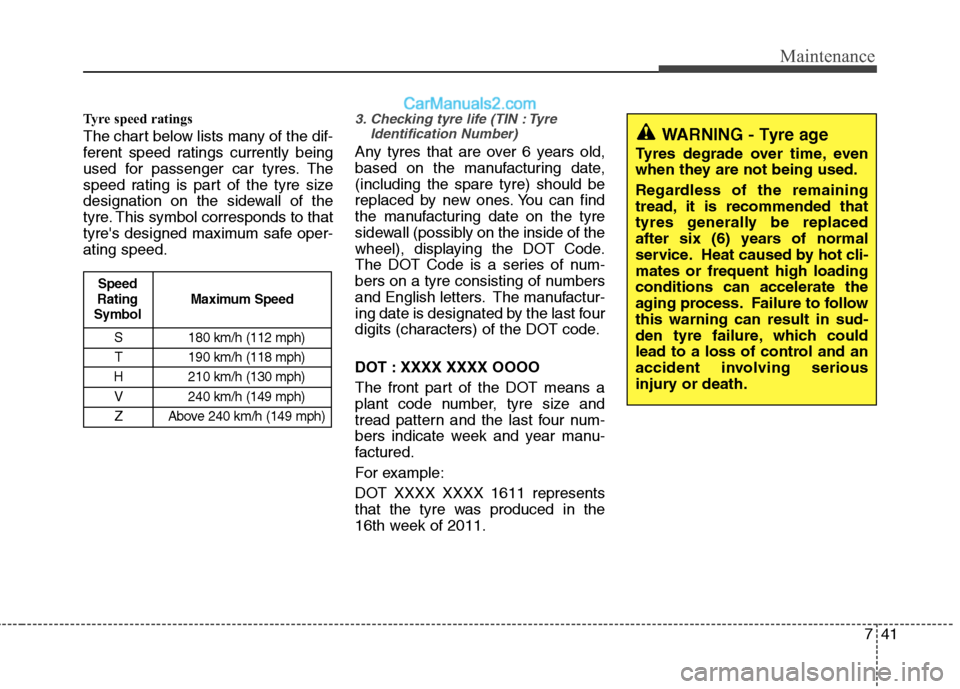
741
Maintenance
Tyre speed ratings
The chart below lists many of the dif-
ferent speed ratings currently being
used for passenger car tyres. The
speed rating is part of the tyre size
designation on the sidewall of the
tyre. This symbol corresponds to that
tyre's designed maximum safe oper-ating speed.3. Checking tyre life (TIN : TyreIdentification Number)
Any tyres that are over 6 years old,
based on the manufacturing date,(including the spare tyre) should be
replaced by new ones. You can find
the manufacturing date on the tyre
sidewall (possibly on the inside of the
wheel), displaying the DOT Code.
The DOT Code is a series of num-
bers on a tyre consisting of numbers
and English letters. The manufactur-
ing date is designated by the last four
digits (characters) of the DOT code.
DOT : XXXX XXXX OOOO
The front part of the DOT means a
plant code number, tyre size and
tread pattern and the last four num-
bers indicate week and year manu-
factured.
For example:
DOT XXXX XXXX 1611 represents
that the tyre was produced in the
16th week of 2011.
S 180 km/h (112 mph)
T 190 km/h (118 mph)
H 210 km/h (130 mph) V 240 km/h (149 mph)
Z Above 240 km/h (149 mph)
Maximum Speed
Speed
Rating
Symbol
WARNING - Tyre age
Tyres degrade over time, even
when they are not being used.
Regardless of the remaining
tread, it is recommended that
tyres generally be replaced
after six (6) years of normal
service. Heat caused by hot cli-mates or frequent high loadingconditions can accelerate the
aging process. Failure to followthis warning can result in sud-
den tyre failure, which could
lead to a loss of control and an
accident involving serious
injury or death.
Page 318 of 363
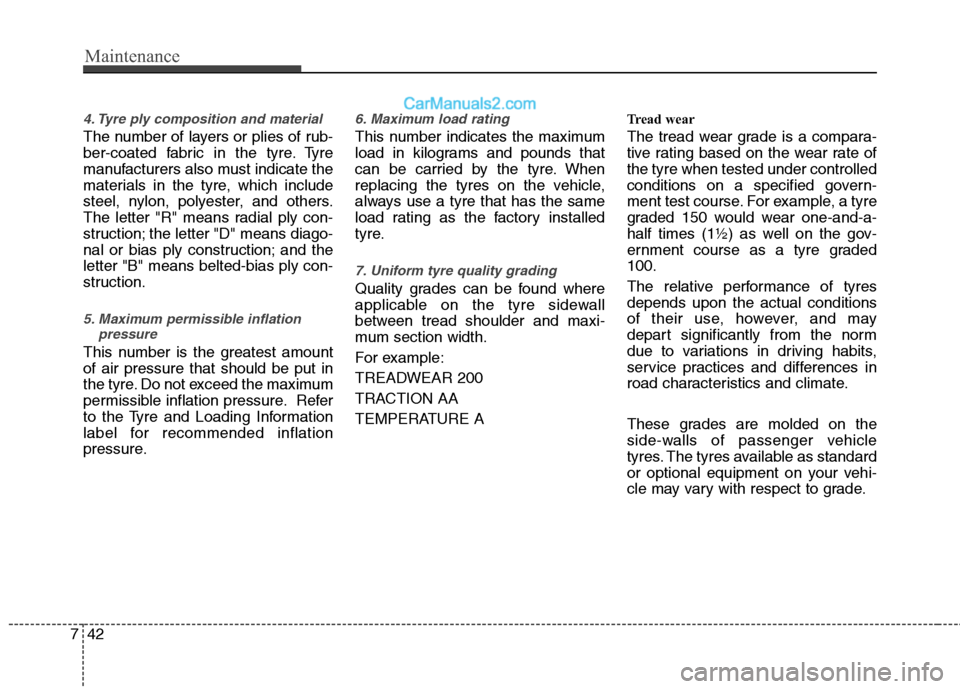
Maintenance
42
7
4. Tyre ply composition and material
The number of layers or plies of rub-
ber-coated fabric in the tyre. Tyre
manufacturers also must indicate the
materials in the tyre, which include
steel, nylon, polyester, and others.
The letter "R" means radial ply con-
struction; the letter "D" means diago-
nal or bias ply construction; and theletter "B" means belted-bias ply con-
struction.
5. Maximum permissible inflation
pressure
This number is the greatest amount of air pressure that should be put in
the tyre. Do not exceed the maximum
permissible inflation pressure. Refer
to the Tyre and Loading Information
label for recommended inflation
pressure.
6. Maximum load rating
This number indicates the maximum
load in kilograms and pounds that
can be carried by the tyre. When
replacing the tyres on the vehicle,
always use a tyre that has the same
load rating as the factory installed
tyre.
7. Uniform tyre quality grading
Quality grades can be found where
applicable on the tyre sidewall
between tread shoulder and maxi-
mum section width.
For example:
TREADWEAR 200
TRACTION AA
TEMPERATURE A Tread wear
The tread wear grade is a compara-
tive rating based on the wear rate ofthe tyre when tested under controlled
conditions on a specified govern-
ment test course. For example, a tyre
graded 150 would wear one-and-a-
half times (1½) as well on the gov-
ernment course as a tyre graded100.
The relative performance of tyres depends upon the actual conditions
of their use, however, and may
depart significantly from the norm
due to variations in driving habits,
service practices and differences in
road characteristics and climate.
These grades are molded on the
side-walls of passenger vehicle
tyres. The tyres available as standard
or optional equipment on your vehi-
cle may vary with respect to grade.
Page 335 of 363
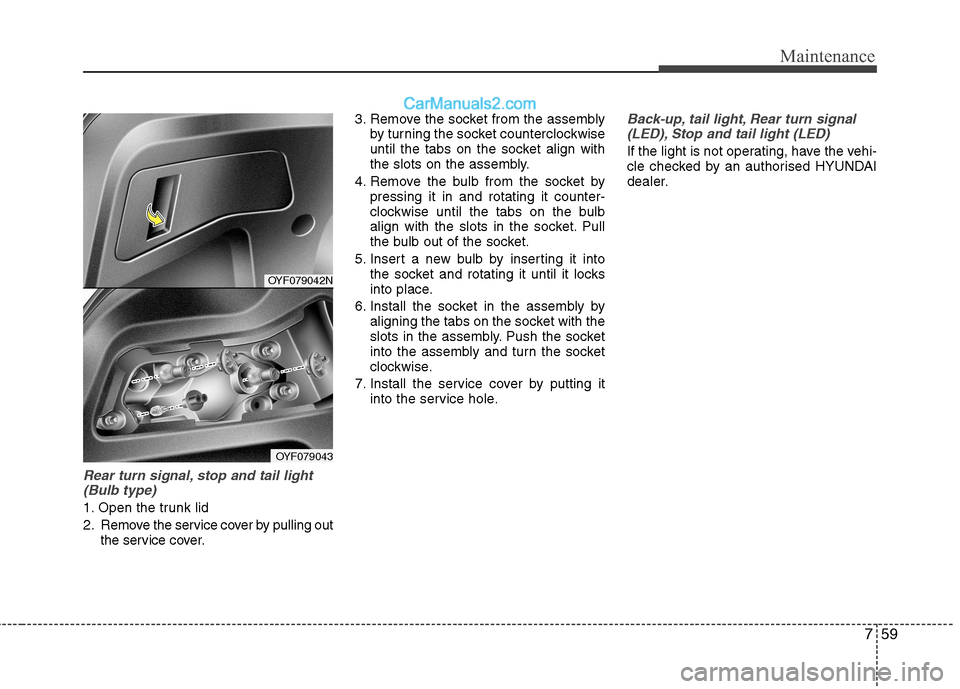
759
Maintenance
Rear turn signal, stop and tail light(Bulb type)
1. Open the trunk lid
2. Remove the service cover by pulling out the service cover. 3. Remove the socket from the assembly
by turning the socket counterclockwise
until the tabs on the socket align with
the slots on the assembly.
4. Remove the bulb from the socket by pressing it in and rotating it counter-
clockwise until the tabs on the bulb
align with the slots in the socket. Pull
the bulb out of the socket.
5. Insert a new bulb by inserting it into the socket and rotating it until it locks
into place.
6. Install the socket in the assembly by aligning the tabs on the socket with the
slots in the assembly. Push the socket
into the assembly and turn the socket
clockwise.
7. Install the service cover by putting it into the service hole.
Back-up, tail light, Rear turn signal
(LED), Stop and tail light (LED)
If the light is not operating, have the vehi-
cle checked by an authorised HYUNDAI
dealer.
OYF079042N
OYF079043
Page 344 of 363

Maintenance
68
7
EMISSION CONTROL SYSTEM (IF EQUIPPED)
The emission control system of your
vehicle is covered by a written limited
warranty. Please see the warranty infor-
mation contained in the Service Passport
in your vehicle.
Your vehicle is equipped with an emis-
sion control system to meet all Australian
Design Rules (ADR) requirements. There are three emission control sys-
tems, as follows.
(1) Crankcase emission control system
(2) Evaporative emission control system(3) Exhaust emission control system In order to assure the proper function of
the emission control systems, it is rec-
ommended that you have your car
inspected and maintained by an autho-
rised HYUNDAI dealer in accordancewith the maintenance schedule in this
manual. Caution for the Inspection and
Maintenance Test (With Electronic
Stability Program (ESP) or Electronic
Stability Control (ESC) system)
To prevent the vehicle from misfiring
during dynamometer testing, turn
the Electronic Stability Program
(ESP) or Electronic Stability Control
(ESC) system off by pressing the
ESP (or ESC) switch.
After dynamometer testing is com- pleted, turn the ESP (or ESC) sys-
tem back on by pressing the ESP (or
ESC) switch again. 1. Crankcase emission control
system
The positive crankcase ventilation sys-
tem is employed to prevent air pollution
caused by blow-by gases being emitted
from the crankcase. This system supplies
fresh filtered air to the crankcase through
the air intake hose. Inside the crankcase,
the fresh air mixes with blow-by gases,
which then pass through the PCV valveinto the induction system.
2. Evaporative emission control system
The Evaporative Emission Control
System is designed to prevent fuel
vapours from escaping into the atmos-
phere.
Page 350 of 363

Specifications & Consumer information
4
8
RECOMMENDED LUBRICANTS AND CAPACITIES
* 1:
Refer to the recommended SAE viscosity numbers on the next page.
* 2:
Engine oils labeled Energy Conserving Oil are now available. Along with other additional benefits, they contribute to fuel econ-
omy by reducing the amount of fuel necessary to overcome engine friction. Often, these improvements are difficult to measure
in everyday driving, but in a year’s time, they can offer significant cost and energy savings.
To help achieve proper engine and powertrain performance and durability, use only lubricants of the proper quality. The correct
lubricants also help promote engine efficiency that results in improved fuel economy.
These lubricants and fluids are recommended for use in your vehicle.
Lubricant Volume Classification
Engine oil * 1
*2
(drain and refill)
2.0 L 4.1
l(4.33 US qt.)
API Service SM*, ILSAC GF-4 or above
* If the API service SM engine oil is not available in your country, you are able to use API service SL.
2.4 L4.5 l(4.75 US qt.)
Engine oil consumptionNormal driving conditionMAX. 1 l /1500 km-
Severe driving conditionMAX. 1 l /1000 km-
Automatic transaxle fluid 7.1
l(7.5 US qt.) MICHANG ATF SP-IV, SK ATF SP-IV
NOCA ATF SP-IV, HYUNDAI genuine ATF & SP-IV
Manual transaxle fluid 1.8
l(1.9 US qt.)
API GL-4, SAE 75W/85
Power steering fluid 0.9
l(0.95 US qt.)
PSF-3
Coolant
AT 6.4
l(6.76 US qt.)
Mixture of antifreeze and water (Ethylene glycol base
coolant for aluminum radiator)
MT6.5 l(6.87 US qt.)
Brake/clutch fluid 0.7~0.8
l
(0.7~0.8 US qt.) FMVSS116 DOT-3 or DOT-4
Fuel 70
l(18.49 US gal.)
Unleaded petrol
Page 359 of 363
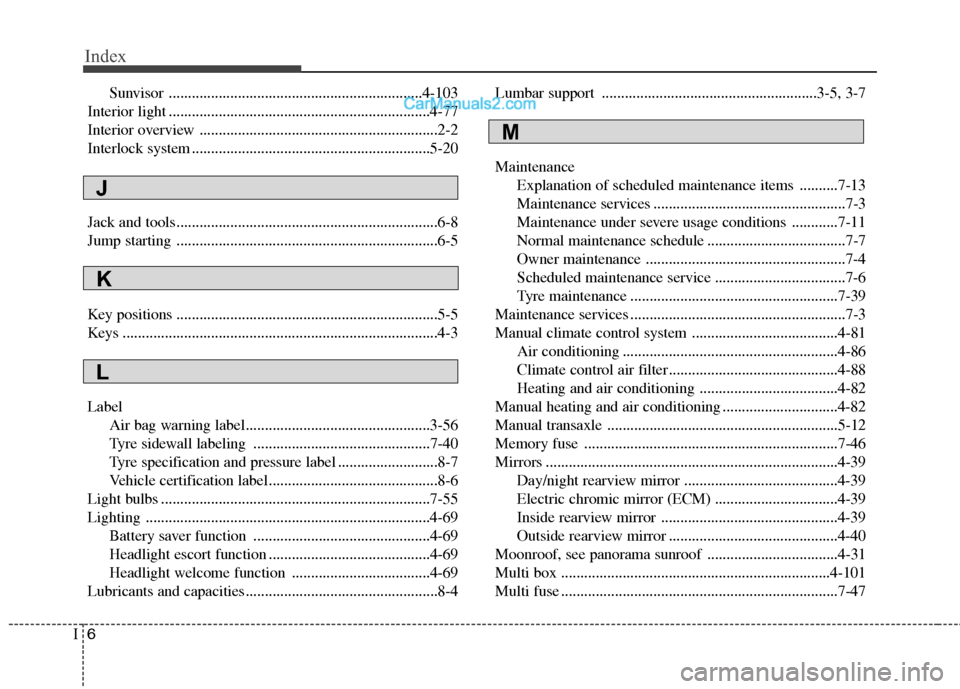
Index
6
I
Sunvisor ..................................................................4-103
Interior light ....................................................................4-77
Interior overview ..............................................................2-2
Interlock system ..............................................................5-20
Jack and tools....................................................................6-8
Jump starting ....................................................................6-5
Key positions ....................................................................5-5
Keys ..................................................................................4-3 Label Air bag warning label................................................3-56
Tyre sidewall labeling ..............................................7-40
Tyre specification and pressure label ..........................8-7
Vehicle certification label............................................8-6
Light bulbs ......................................................................7-55
Lighting ..........................................................................4-69 Battery saver function ..............................................4-69
Headlight escort function ..........................................4-69
Headlight welcome function ....................................4-69
Lubricants and capacities ..................................................8-4 Lumbar support ........................................................3-5, 3-7 Maintenance
Explanation of scheduled maintenance items ..........7-13
Maintenance services ..................................................7-3
Maintenance under severe usage conditions ............7-11
Normal maintenance schedule ....................................7-7
Owner maintenance ....................................................7-4
Scheduled maintenance service ..................................7-6
Tyre maintenance ......................................................7-39
Maintenance services ........................................................7-3
Manual climate control system ......................................4-81 Air conditioning ........................................................4-86
Climate control air filter............................................4-88
Heating and air conditioning ....................................4-82
Manual heating and air conditioning ..............................4-82
Manual transaxle ............................................................5-12
Memory fuse ..................................................................7-46
Mirrors ............................................................................4-39 Day/night rearview mirror ........................................4-39
Electric chromic mirror (ECM) ................................4-39
Inside rearview mirror ..............................................4-39
Outside rearview mirror ............................................4-40
Moonroof, see panorama sunroof ..................................4-31
Multi box ......................................................................4-101
Multi fuse ........................................................................7-47
M
K
L
J
Page 360 of 363
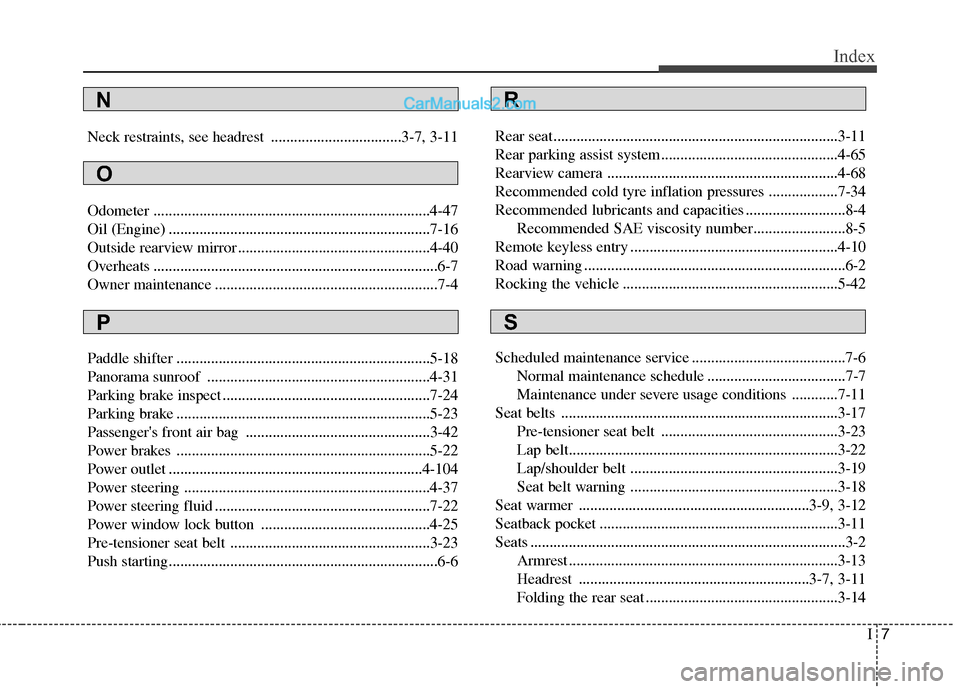
I7
Index
Neck restraints, see headrest ..................................3-7, 3-11
Odometer ........................................................................4-47
Oil (Engine) ....................................................................7-16
Outside rearview mirror ..................................................4-40
Overheats ..........................................................................6-7
Owner maintenance ..........................................................7-4
Paddle shifter ..................................................................5-18
Panorama sunroof ..........................................................4-31
Parking brake inspect ......................................................7-24
Parking brake ..................................................................5-23
Passenger's front air bag ................................................3-42
Power brakes ..................................................................5-22
Power outlet ..................................................................4-104
Power steering ................................................................4-37
Power steering fluid ........................................................7-22
Power window lock button ............................................4-25
Pre-tensioner seat belt ....................................................3-23
Push starting......................................................................6-6 Rear seat..........................................................................3-11
Rear parking assist system ..............................................4-65
Rearview camera ............................................................4-68
Recommended cold tyre inflation pressures ..................7-34
Recommended lubricants and capacities ..........................8-4
Recommended SAE viscosity number........................8-5
Remote keyless entry ......................................................4-10
Road warning ....................................................................6-2
Rocking the vehicle ........................................................5-42
Scheduled maintenance service ........................................7-6 Normal maintenance schedule ....................................7-7
Maintenance under severe usage conditions ............7-11
Seat belts ........................................................................3-17 Pre-tensioner seat belt ..............................................3-23
Lap belt......................................................................3-22
Lap/shoulder belt ......................................................3-19
Seat belt warning ......................................................3-18
Seat warmer ............................................................3-9, 3-12
Seatback pocket ..............................................................3-11
Seats ..................................................................................3-2 Armrest ......................................................................3-13
Headrest ............................................................3-7, 3-11
Folding the rear seat ..................................................3-14
O
P
NR
S